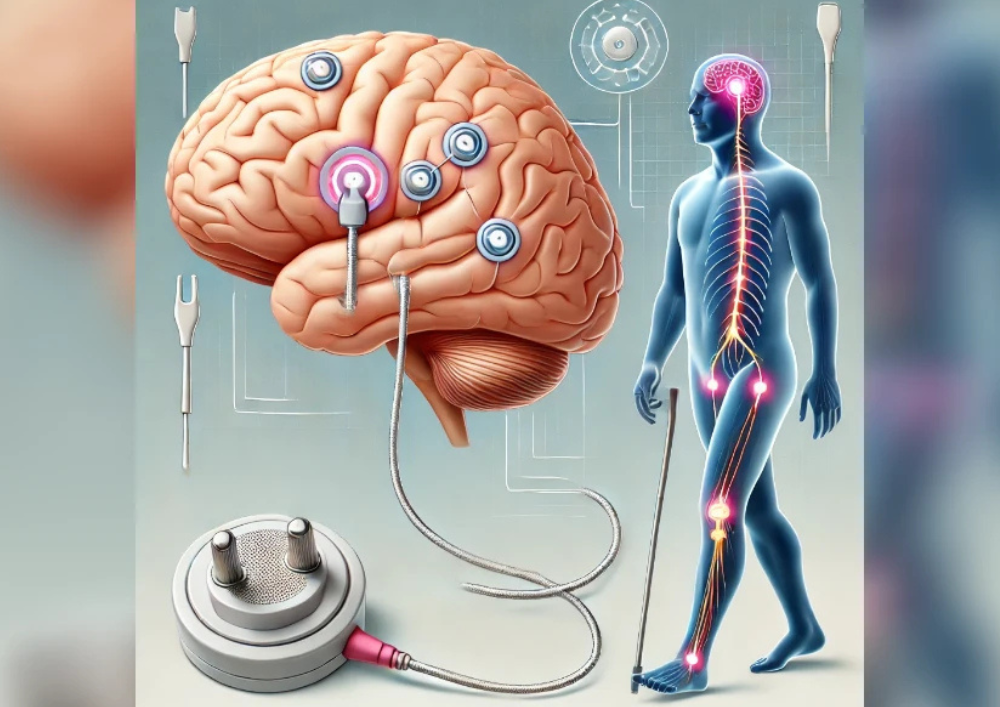
By Scihealthhub – January 11, 2025
A new study published in Nature Medicine has uncovered a way to improve walking in people and animals with spinal cord injuries (SCI) by targeting a specific area of the brain using deep brain stimulation (DBS). This exciting discovery could bring hope to those living with paralysis or limited mobility due to spinal cord injury.
The Problem with Walking After Spinal Cord Injury
Spinal cord injuries can damage the connection between the brain and the spinal cord, making it hard or impossible to move the limbs. If the injury is complete, it can lead to total loss of movement (paralysis) below the point of injury. In some cases, where the injury is incomplete, the brain manages to restore some movement over time, but this recovery is often partial and not enough for walking without help.
The Study
Researchers, led by Gregoire Courtine and Jocelyne Bloch, studied how the brain helps in walking recovery after spinal cord injury. They discovered that a small area of the brain called the lateral hypothalamus (LH) plays a surprising role in this process.
The LH, which is usually known for controlling emotions and motivation, was found to contain a group of neurons (nerve cells) that become very active when walking improves after a spinal cord injury. These neurons were named glutamatergic neurons, and the scientists found that they are key to helping people and animals regain their ability to walk.
What the Researchers Did
1. Testing in Mice
The team worked with mice that had spinal cord injuries and tested ways to stimulate the neurons in the LH. They used light and other tools to activate these neurons. When the neurons were “switched on,” the mice could walk better, even jumping at higher stimulation levels.
2. Deep Brain Stimulation (DBS)
The researchers then tried deep brain stimulation, a technique that uses small electrical pulses to stimulate specific areas of the brain. They applied this to the LH in mice and rats with spinal cord injuries. It worked: the animals could walk better almost immediately, and the effects lasted.
3. Testing in Humans
Two people with long-term spinal cord injuries also participated in an early human trial of this technique. Both had difficulty walking and relied on devices for support. After the brain stimulation, they were able to move their legs better and perform walking tests with improved results. Importantly, the improvements in both patients was sustained long after the stimulation was turned off. Also, there were no harmful side effects.
Why It Works
The brain’s LH neurons seem to work with another area of the brainstem, helping send movement signals to the spinal cord, even when the spinal cord is injured. By stimulating these neurons, the brain can “reorganize” how it communicates with the spinal cord, allowing better control of the legs.
What’s Next?
This study is a big step forward, but more work is needed. Larger trials with more people are required to make sure this approach is safe and effective in the long run. Researchers also want to see how this treatment might affect other parts of the body, such as hormones, emotions, and internal systems like the heart and digestion.
Conclusion
Deep brain stimulation of the LH is a promising new way to help people with spinal cord injuries walk again. It shows that the brain has untapped potential for recovery, and with the right technology, we can help people regain independence and improve their quality of life.
Looking Ahead
As research continues, we may be getting closer to a specific and complete treatment for spinal cord injury. Stay updated with us for more breakthroughs in spinal cord injury recovery!



